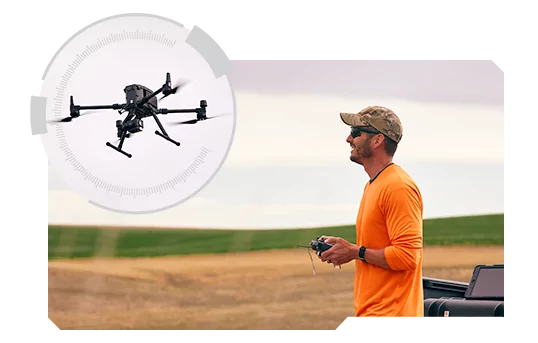

Drone farming leverages unmanned aerial vehicles (UAVs) equipped with sophisticated sensors and cameras to collect detailed leaf-level imagery of your fields. Combined with artificial intelligence (AI), data ranges from plant and soil health to pest infestations and yield potential, empowering farmers to make informed decisions that optimize their operations and boost their bottom line.

Drone farming typically involves three stages:
Drone farming has a wide range of applications, including:
Taranis AcreForward is a comprehensive drone farming solution that takes the guesswork out of implementing this transformative technology. Our platform provides:
Drone farming is no longer a futuristic concept; it’s a readily available tool that can revolutionize your agricultural operations. By embracing this technology and leveraging the power of data, you can unlock a new era of precision, efficiency, and sustainability in your farming practices.
Drones are employed in farming for diverse tasks. Equipped with sensors, they capture high-resolution images of crops, enabling farmers to monitor health, detect pests, diseases, and optimize irrigation and fertilization. By generating 3D maps of farmland, drones aid in soil analysis, drainage assessment, and precision agriculture planning. Some drones are outfitted with spraying systems for precise application of pesticides, herbicides, and fertilizers, minimizing chemical usage and environmental impact. They also facilitate livestock monitoring by providing aerial views of herds, aiding in health assessment and grazing management. Furthermore, drones help in water management by identifying irrigation system issues and water stress in crops, promoting efficient water use. They aid in yield estimation and early detection of pest infestation or disease outbreaks, enabling timely interventions to minimize crop losses. Overall, drones offer farmers cost-effective tools for data-driven decision-making, enhancing crop productivity, sustainability, and resource management in modern agriculture.
In many countries, specific licenses or certifications may be required to legally fly agricultural drones, especially if they are used for commercial purposes. These requirements vary depending on the regulations set by aviation authorities and may include:
Remote Pilot Certificate: Pilots may need to obtain a remote pilot certificate or license issued by the relevant aviation authority. This typically involves passing a knowledge test on drone regulations, airspace rules, and safety procedures.
Agricultural Aviation License: Some jurisdictions may require additional licensing or certification specifically for agricultural drone operations. This could involve training on crop spraying techniques, pesticide application regulations, and safety protocols.
Insurance and Registration: Operators may need to insure their drones and register them with the aviation authority. Insurance coverage is often required to protect against liability in case of accidents or property damage.
Permissions and Authorizations: Depending on the specific operations and local regulations, operators may need to obtain permissions or authorizations for certain activities, such as flying in controlled airspace or over populated areas.
It’s essential for drone operators to familiarize themselves with the regulations applicable in their region and ensure compliance to operate legally and safely. Failure to comply with licensing requirements can result in fines, penalties, or other legal consequences.
Drone farming offers several avenues to enhance productivity in agriculture:
Data-Driven Decision Making: Drones equipped with sensors can collect vast amounts of data about crop health, soil conditions, and other variables. This data enables farmers to make more informed decisions about irrigation, fertilization, and pest management, leading to optimized resource allocation and increased yields.
Precision Agriculture: By providing detailed information about individual plants or sections of fields, drones enable precision agriculture techniques. This allows farmers to apply inputs such as water, nutrients, and pesticides more precisely, minimizing waste and maximizing effectiveness.
Efficient Monitoring and Management: Drones can cover large areas of farmland quickly and easily, allowing farmers to monitor crops more frequently and efficiently than traditional methods. This timely monitoring facilitates early detection of issues such as pest infestations or nutrient deficiencies, enabling prompt interventions to mitigate crop losses.
Labor and Time Savings: Compared to manual labor or ground-based machinery, drones require less time and human effort to collect data and perform tasks such as crop scouting or spraying. This frees up labor resources for other farm activities and reduces the time required to complete essential tasks, ultimately increasing overall productivity.
Overall, drone farming empowers farmers with the tools and insights needed to optimize their operations, improve efficiency, and achieve higher levels of productivity in modern agriculture.